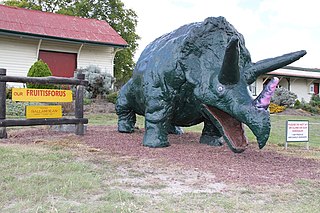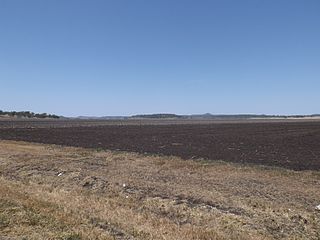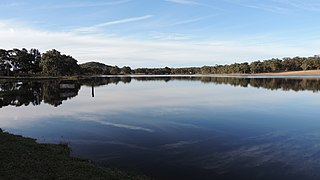
Stanthorpe is a rural town and locality in the Southern Downs Region, Queensland, Australia. In the 2021 census, the locality of Stanthorpe had a population of 5,286 people.

Wallangarra is a rural town and locality in the Southern Downs Region, Queensland, Australia on the border with New South Wales. It is the third-most southerly town in Queensland, 258 kilometres (160 mi) south west of Brisbane. Wallangarra is on the Queensland side of the border and Jennings is on the New South Wales side.

The Granite Belt is an area of the Great Dividing Range in the Darling Downs region of Queensland and the New England region of New South Wales, Australia. The Granite Belt is centred on the town of Stanthorpe. The cool, high country of the granite belt is located on Queensland's southern border. It is the northernmost part of the New England Tablelands.

Wondai is a rural town and locality in the South Burnett Region, Queensland, Australia. In the 2021 census, Wondai had a population of 1,975 people.

Leyburn is a rural town in the Southern Downs Region and a locality split between the South Downs Region and the Toowoomba Region in Queensland, Australia. In the 2016 census, Leyburn had a population of 476 people.

Applethorpe is a rural town and locality in the Southern Downs Region, Queensland, Australia. It is on Queensland's border with New South Wales. It is well known for the production of apples. It often records the lowest temperatures in Queensland.

Ballandean is a rural town and locality in the Southern Downs Region, Queensland, Australia. In the 2021 census, the locality of Ballandean had a population of 316 people.

Dalveen is a town and a locality in the Southern Downs Region, Queensland, Australia. It borders New South Wales. In the 2016 census, Dalveen had a population of 335 people.

Mount Tyson is a rural town and locality in the Toowoomba Region, Queensland, Australia. In the 2016 census, the locality of Mount Tyson had a population of 285 people.

St Denys Anglican Church is a heritage-listed church at 17 Trevethan Lane, Amiens, Southern Downs Region, Queensland, Australia. It was built from 1923 to 1923. It is also known as Church of St Denys. It was added to the Queensland Heritage Register on 3 August 2005.

The Summit is a rural town and locality in the Southern Downs Region, Queensland, Australia. In the 2016 census, the locality of The Summit had a population of 409 people.

Storm King Dam is a reservoir created by the dam of the same name in the locality of Storm King in the Southern Downs Region, Queensland, Australia. It provides water for the town of Stanthorpe.
Limevale is a rural locality in the Goondiwindi Region, Queensland, Australia. In the 2021 census, Limevale had a population of 49 people.

Oman Ama is a rural locality in the Goondiwindi Region, Queensland, Australia. In the 2021 census, Oman Ama had a population of 31 people.
Pikedale is a rural locality in the Southern Downs Region, Queensland, Australia. It is one of the areas used for soldier settlements following service in World War I.
Glen Aplin is a rural locality in the Southern Downs Region, Queensland, Australia. In the 2021 census, Glen Aplin had a population of 566 people.
Pozieres is a rural locality in the Southern Downs Region, Queensland, Australia. In the 2021 census, Pozieres had a population of 208 people.
Kooroongarra is a rural town and locality in the Toowoomba Region, Queensland, Australia. In the 2016 census, the locality of Kooroongarra had a population of 58 people.
Passchendaele is a rural locality in the Southern Downs Region, Queensland, Australia. In the 2021 census, Passchendaele had a population of 42 people.
Sugarloaf is a rural locality in the Southern Downs Region, Queensland, Australia. In the 2021 census, Sugarloaf had a population of 162 people.




















